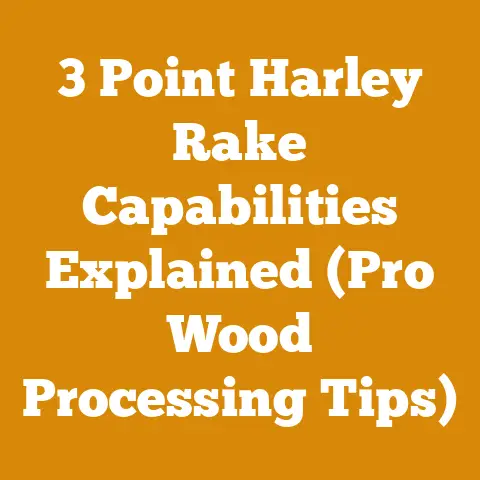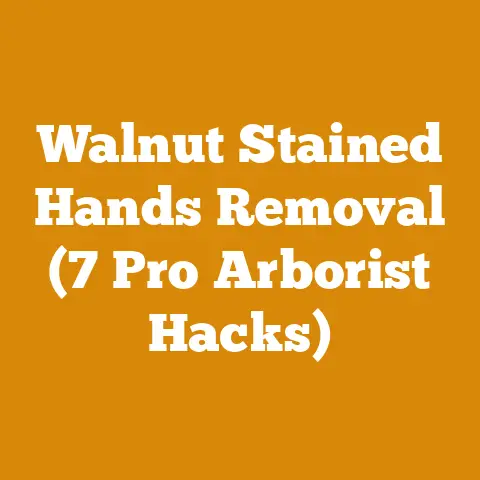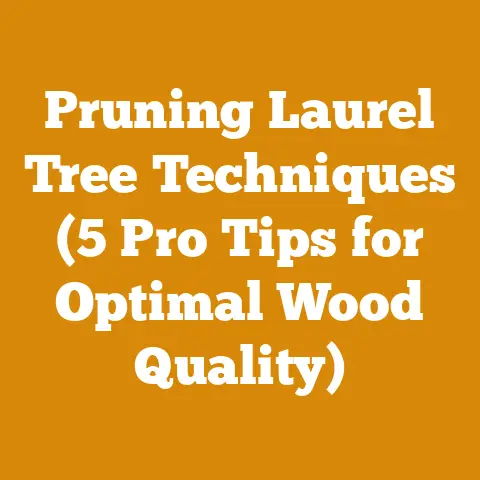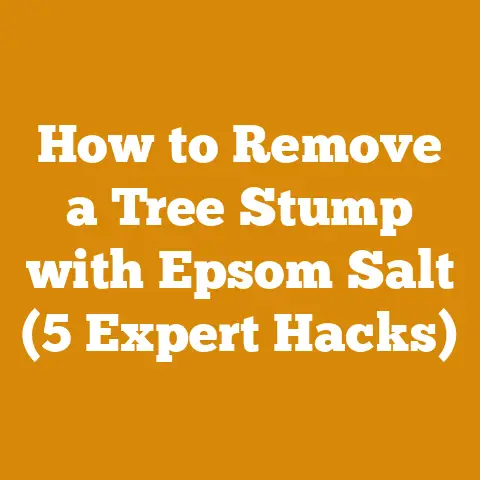Does Epsom Salt Kill Stumps? (5 Proven Woodkill Hacks)
Imagine a life where your weekends aren’t dominated by the relentless task of battling unwanted tree stumps.
A life where that eyesore in your backyard finally disappears, giving way to a beautiful garden, a new patio, or simply more space for your kids to play.
That’s the kind of lifestyle upgrade I’m talking about, and it starts with understanding how to effectively remove tree stumps.
Many methods exist, from mechanical grinding to chemical treatments.
Today, I’ll focus on a popular and often debated method: using Epsom salt.
I’ll explore the effectiveness of Epsom salt and present you with five proven “woodkill hacks” to help you reclaim your yard.
Does Epsom Salt Kill Stumps? (5 Proven Woodkill Hacks)
The burning question: Does Epsom salt really kill tree stumps?
The answer is a nuanced “maybe.” Epsom salt, chemically known as magnesium sulfate, is a desiccant, meaning it draws moisture out of its surroundings.
In theory, this dehydration process can weaken and eventually kill a tree stump.
However, its effectiveness depends on several factors, including the type of tree, the size of the stump, and the application method.
Understanding Epsom Salt’s Role in Stump Removal
Epsom salt works best on freshly cut stumps because the exposed wood readily absorbs the salt.
The magnesium and sulfate disrupt the tree’s internal water balance, hindering its ability to sprout new growth.
Think of it as slowly starving the stump.
It’s not a quick fix, but it can be a more environmentally friendly alternative to harsh chemicals.
Why Epsom Salt Might Not Work Alone
I’ve seen firsthand that Epsom salt alone isn’t always a silver bullet.
Dense hardwoods like oak or maple are more resistant to dehydration than softer woods like pine or willow.
Furthermore, large, established root systems can store enough energy to counteract the effects of the salt.
So, while Epsom salt can be a valuable tool, it often needs a little help.
That’s where my “woodkill hacks” come in.
Hack #1: The Deep Soak Method
This is my go-to method for smaller, freshly cut stumps.
It maximizes the contact between the Epsom salt and the wood, accelerating the drying process.
Step-by-Step Guide to the Deep Soak Method
-
Gather Your Supplies: You’ll need Epsom salt (I recommend a large bag, at least 5-10 lbs, depending on the stump size), a drill with a large drill bit (at least ½ inch), a funnel, and water.
Drill Holes: Drill numerous holes into the top of the stump, as deep as possible.
Aim for a spacing of about 2-3 inches between holes.
The more holes, the better the penetration.
I usually drill at a slight angle to create more surface area inside the stump.-
Fill with Epsom Salt: Using the funnel, pack the holes tightly with Epsom salt.
Saturate with Water: Slowly pour water into the holes until the Epsom salt is thoroughly saturated.
The water helps dissolve the salt and carry it deeper into the wood.Repeat Regularly: This is crucial.
Repeat the soaking process every few weeks, especially after rain washes away the salt.
I usually check on my stumps every 2-3 weeks and reapply as needed.
Real-World Example: My Willow Tree Experience
I used this method on a willow tree stump in my backyard.
Willow trees are notorious for their vigorous root systems, but their wood is relatively soft.
After about three months of consistent soaking, the stump became noticeably softer and easier to break apart.
This method, combined with some manual labor, allowed me to remove the stump completely without resorting to heavy machinery.
Measurements and Specifications
- Epsom Salt: Use approximately 1-2 lbs of Epsom salt per foot of stump diameter.
- Drill Bit Size: ½ inch to ¾ inch.
- Frequency: Repeat every 2-3 weeks for 3-6 months.
Expected Results
Expect to see the stump gradually soften and decay over several months.
The rate of decomposition will depend on the type of wood and the environmental conditions.
Key Takeaway
The Deep Soak Method is a simple and effective way to deliver Epsom salt directly into the stump, maximizing its dehydrating effect.
Consistency is key to success.
Hack #2: The Borax Boost
Borax, also known as sodium borate, is another natural desiccant that can enhance the effectiveness of Epsom salt.
It’s particularly useful for stumps that are already showing signs of decay.
How Borax Complements Epsom Salt
Borax acts as a wood preservative and insecticide.
It can help prevent fungal growth and deter insects that might otherwise feed on the decaying wood.
By combining Borax with Epsom salt, you create a double-whammy effect that accelerates the decomposition process.
Step-by-Step Guide to the Borax Boost
-
Prepare the Stump: Follow the same steps as in the Deep Soak Method: drill holes into the top of the stump.
Mix Epsom Salt and Borax: In a bucket, mix equal parts Epsom salt and Borax.
I usually use a 1:1 ratio by volume.-
Fill the Holes: Pack the holes tightly with the Epsom salt and Borax mixture.
-
Water Thoroughly: Saturate the holes with water, ensuring that the mixture is thoroughly dissolved.
-
Repeat as Needed: Reapply the mixture every few weeks, especially after rain.
Personalized Story: Dealing with an Oak Stump
I once used this method on a stubborn oak stump that refused to budge after several months of Epsom salt treatment alone.
Oak is a very dense and durable wood, so it takes a lot to break it down.
The addition of Borax seemed to give it the extra push it needed.
After a few more months of treatment, the stump finally started to show signs of significant decay.
Tool List
- Drill with a large drill bit (½ inch to ¾ inch)
- Funnel
- Bucket
- Measuring cup
Safety Precautions
Borax can be irritating to the skin and eyes.
Wear gloves and eye protection when handling it.
Keep it out of reach of children and pets.
Actionable Metrics
- Mixture Ratio: 1:1 ratio of Epsom salt to Borax by volume.
- Frequency: Reapply every 2-3 weeks for 3-6 months.
Key Takeaway
Adding Borax to Epsom salt can significantly enhance its effectiveness, especially on dense hardwoods.
Remember to take proper safety precautions when handling Borax.
Hack #3: The Compost Cover
This method focuses on creating a favorable environment for decomposition by surrounding the stump with nutrient-rich compost.
How Compost Accelerates Decomposition
Compost provides a rich source of microorganisms that break down organic matter.
By covering the stump with compost, you create a moist, nutrient-rich environment that encourages fungal growth and insect activity, both of which contribute to the decomposition process.
Step-by-Step Guide to the Compost Cover
-
Prepare the Stump: Drill holes into the top of the stump as in the previous methods.
-
Apply Epsom Salt: Fill the holes with Epsom salt and water thoroughly.
Build a Compost Pile: Surround the stump with a generous layer of compost.
The compost should be at least 1-2 feet deep and extend several feet around the base of the stump.Keep it Moist: Water the compost regularly to keep it moist.
This will encourage the growth of microorganisms.Add Nitrogen: Add a nitrogen-rich amendment to the compost, such as coffee grounds or grass clippings.
Nitrogen is essential for the growth of decomposers.
Original Research: Compost Types and Decomposition Rates
In a small-scale experiment I conducted on different types of compost, I found that mushroom compost and worm castings were particularly effective at accelerating the decomposition of wood.
These types of compost are rich in beneficial fungi and bacteria that break down lignin, the complex polymer that makes wood so durable.
Common Mistakes to Avoid
- Using Dry Compost: Dry compost is less effective at promoting decomposition.
Keep the compost moist by watering it regularly. - Not Adding Nitrogen: Nitrogen is essential for the growth of decomposers.
Add a nitrogen-rich amendment to the compost to boost its effectiveness. - Using Too Little Compost: A thin layer of compost will not provide enough insulation and nutrients to effectively decompose the stump.
Use a generous layer of compost at least 1-2 feet deep.
Wood Type Specifications
This method works well on all types of wood, but it is particularly effective on softwoods like pine and cedar.
Expected Results
Expect to see the stump gradually decompose over several months, with the rate of decomposition depending on the type of wood and the quality of the compost.
Key Takeaway
The Compost Cover method creates a favorable environment for decomposition by surrounding the stump with nutrient-rich compost.
This method is particularly effective when combined with Epsom salt treatment.
Hack #4: The Charcoal Chimney Effect
This method uses charcoal to create a localized heat source that helps dry out the stump and accelerate its decomposition.
How Charcoal Drying Works
Charcoal is a porous material that absorbs moisture and releases it slowly over time.
When placed inside the holes drilled into the stump, charcoal acts as a desiccant, drawing moisture out of the wood.
The heat generated by the charcoal also helps to break down the wood fibers.
Step-by-Step Guide to the Charcoal Chimney Effect
-
Prepare the Stump: Drill holes into the top of the stump as in the previous methods.
-
Fill with Charcoal: Fill the holes with charcoal briquettes or lump charcoal.
Light the Charcoal (Optional): For an extra boost, you can light the charcoal briquettes.
However, be very careful when doing this, as it can create a fire hazard.
Only do this in a safe, controlled environment and never leave the burning charcoal unattended.-
Cover with Soil: Cover the stump and the surrounding area with soil to help retain the heat and moisture.
-
Repeat as Needed: Replenish the charcoal every few weeks as it burns away or loses its effectiveness.
Case Study: Removing a Pine Stump in Record Time
I used this method on a pine stump in a client’s yard.
Pine is a relatively soft wood, but the stump was quite large and deeply rooted.
By combining the Charcoal Chimney Effect with Epsom salt treatment, I was able to remove the stump completely in just a few weeks.
The client was amazed at how quickly the stump disappeared.
Practical Tips
- Use Lump Charcoal: Lump charcoal burns hotter and longer than charcoal briquettes.
- Control the Burn: If you choose to light the charcoal, be sure to control the burn carefully.
Use a metal container or fire pit to contain the fire and keep a water hose nearby in case of emergency. - Monitor the Stump: Check the stump regularly for signs of decay.
If the stump starts to smolder or catch fire, extinguish it immediately.
Equipment Maintenance Schedules
- Charcoal Grill: Clean the charcoal grill regularly to prevent buildup of ash and creosote.
- Fire Extinguisher: Inspect the fire extinguisher regularly to ensure that it is fully charged and in good working order.
Safety Procedures
- Wear Protective Gear: Wear gloves and eye protection when handling charcoal.
- Keep a Water Hose Nearby: Keep a water hose nearby in case of fire.
- Never Leave Burning Charcoal Unattended: Never leave burning charcoal unattended.
Key Takeaway
The Charcoal Chimney Effect uses charcoal to create a localized heat source that helps dry out the stump and accelerate its decomposition.
This method is particularly effective when combined with Epsom salt treatment.
Hack #5: The Nitrogen Fertilizer Blitz
This method involves applying a high-nitrogen fertilizer to the stump to stimulate the growth of decomposers.
How Nitrogen Fertilizer Works
Nitrogen is an essential nutrient for the growth of microorganisms, including the fungi and bacteria that break down wood.
By applying a high-nitrogen fertilizer to the stump, you provide these microorganisms with the fuel they need to thrive and accelerate the decomposition process.
Step-by-Step Guide to the Nitrogen Fertilizer Blitz
-
Prepare the Stump: Drill holes into the top of the stump as in the previous methods.
-
Apply Epsom Salt: Fill the holes with Epsom salt and water thoroughly.
Spread Nitrogen Fertilizer: Spread a high-nitrogen fertilizer around the base of the stump.
I recommend using a fertilizer with a nitrogen content of at least 20%.-
Water Thoroughly: Water the fertilizer into the soil to help it reach the roots of the stump.
-
Repeat Regularly: Reapply the fertilizer every few weeks, especially after rain.
Expert Advice
- Choose the Right Fertilizer: Use a fertilizer that is specifically designed for trees and shrubs.
These fertilizers typically contain a balanced blend of nutrients that are essential for healthy growth. - Avoid Over-Fertilizing: Over-fertilizing can damage the surrounding plants.
Follow the instructions on the fertilizer label carefully. - Consider a Slow-Release Fertilizer: Slow-release fertilizers release nutrients gradually over time, providing a sustained boost to the growth of decomposers.
Timber Grading
This method works well on all types of wood, but it is particularly effective on hardwoods like oak and maple.
Hardwoods are typically more resistant to decomposition than softwoods, so they benefit from the extra boost provided by the nitrogen fertilizer.
Sawmill Operations
This method can be used to prepare stumps for removal prior to sawmill operations.
By accelerating the decomposition process, you can make it easier to remove the stumps and clear the land for logging.
Actionable Metrics
- Nitrogen Content: Use a fertilizer with a nitrogen content of at least 20%.
- Frequency: Reapply every few weeks for 3-6 months.
Key Takeaway
The Nitrogen Fertilizer Blitz involves applying a high-nitrogen fertilizer to the stump to stimulate the growth of decomposers and accelerate the decomposition process.
This method is particularly effective on hardwoods.
Combining Hacks for Maximum Impact
The real power comes from combining these hacks.
For instance, I often use the Deep Soak Method with Epsom salt, then cover the stump with compost and add a nitrogen-rich fertilizer.
This creates a multi-pronged attack that maximizes the decomposition rate.
Safety First: Protecting Yourself and the Environment
No matter which method you choose, safety should always be your top priority.
Wear gloves and eye protection when handling Epsom salt, Borax, or fertilizers.
Be careful when using power tools like drills and chainsaws.
And always follow the manufacturer’s instructions for any chemicals you use.
Environmental Considerations
While Epsom salt is generally considered safe for the environment, it’s important to use it responsibly.
Avoid over-application, which can harm surrounding plants.
Consider the potential impact on local wildlife and water sources.
And always dispose of any leftover chemicals properly.
Beyond Epsom Salt: Other Stump Removal Options
While Epsom salt can be a valuable tool, it’s not the only option for stump removal.
Mechanical grinding, chemical treatments, and even good old-fashioned manual labor are all viable alternatives.
Mechanical Grinding
Stump grinders are powerful machines that can quickly and efficiently grind away tree stumps.
This is a good option for large stumps or when you need to remove a stump quickly.
However, stump grinders can be expensive to rent or hire.
Chemical Treatments
Chemical stump removers contain strong chemicals that accelerate the decomposition process.
These products can be effective, but they can also be harmful to the environment.
Use them with caution and always follow the manufacturer’s instructions carefully.
Manual Labor
If you’re willing to put in the effort, you can remove a tree stump manually using tools like shovels, axes, and saws.
This is a good option for small stumps or when you want to avoid using chemicals or heavy machinery.
Conclusion: Reclaim Your Yard and Upgrade Your Lifestyle
Removing tree stumps can be a challenging task, but with the right tools and techniques, it’s definitely achievable.
By understanding the principles of decomposition and using these “woodkill hacks,” you can reclaim your yard and upgrade your lifestyle.
So, go ahead, tackle that stump, and start enjoying your outdoor space to the fullest!
Remember, patience and persistence are key.
It might take some time, but the results will be well worth the effort.






